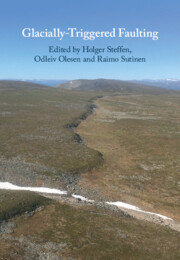Book contents
- Glacially-Triggered Faulting
- Glacially-Triggered Faulting
- Copyright page
- Contents
- Figures
- Tables
- Contributors
- Preface
- Part I Introduction
- Part II Methods and Techniques for Fault Identification and Dating
- Part III Glacially Triggered Faulting in the Fennoscandian Shield
- Part IV Glacially Triggered Faulting at the Edge and in the Periphery of the Fennoscandian Shield
- Part V Glacially Triggered Faulting Outside Europe
- Part VI Modelling of Glacially Induced Faults and Stress
- Part VII Outlook
- Index
- References
Part III - Glacially Triggered Faulting in the Fennoscandian Shield
Published online by Cambridge University Press: 02 December 2021
- Glacially-Triggered Faulting
- Glacially-Triggered Faulting
- Copyright page
- Contents
- Figures
- Tables
- Contributors
- Preface
- Part I Introduction
- Part II Methods and Techniques for Fault Identification and Dating
- Part III Glacially Triggered Faulting in the Fennoscandian Shield
- Part IV Glacially Triggered Faulting at the Edge and in the Periphery of the Fennoscandian Shield
- Part V Glacially Triggered Faulting Outside Europe
- Part VI Modelling of Glacially Induced Faults and Stress
- Part VII Outlook
- Index
- References
Summary
The most prominent fault scarps are found in northern Fennoscandia in the northernmost parts of Norway, Sweden and Finland. In addition, signs of glacially triggered faulting were identified in adjacent Russia. The following chapters give an overview about these faults from their identification until the very recent results that include, among other things, new reactivation dating and revised fault geometries at the surface from laser scanning.
- Type
- Chapter
- Information
- Glacially-Triggered Faulting , pp. 175 - 260Publisher: Cambridge University PressPrint publication year: 2021



